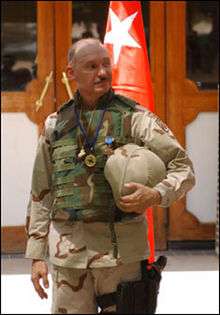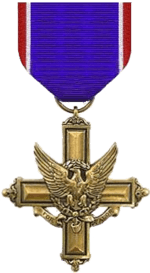James H. Coffman, Jr.
| James Henry Coffman, Jr. | |
|---|---|
 U.S. Army Col. James H. Coffman Jr. after being awarded the Distinguished Service Cross | |
| Born | Barrington, Massachusetts |
| Allegiance |
|
| Service/branch |
|
| Years of service | 1978 - present |
| Rank |
|
| Battles/wars | Iraq War |
| Awards |
|
Colonel James Henry Coffman, Jr. is an U.S. Army officer who was awarded the Distinguished Service Cross for valorous conduct while serving as an advisor with the Multi-National Security Transition Command – Iraq attached to the Iraqi Special Police Commandos in Mosul, Iraq in 2004.[1]
Early life and education
Coffman grew up in Great Barrington, Massachusetts, and enlisted in the United States Army in 1972. He graduated from the United States Military Academy at West Point, New York in 1978.[2] Coffman subsequently earned a Master of Science degree in National Security Affairs from the Naval Postgraduate School. He was also a U.S. Army Fellow at the Fletcher School of Law and Diplomacy at Tufts University, and attended the Boston University Overseas Program for Master of Science in International Relations in Vicenza, Italy.[3] In the course of his formal education Coffman has authored papers on ethnic conflict in the post-Cold War world.[4][5]
Iraq war counter-insurgency activities
In 2004, during the US occupation of Iraq, Coffman was sent as a civilian adviser to train the Special Police Commandos; a paramilitary unit known as the Wolf Brigade that was later accused by a UN official of torture and murder, and which was also implicated in the use of death squads.[6][7][8] The Wolf Brigade was created and supported by the US and it enabled the redeployment of Saddam Hussein's Republican Guard but with the new task of terrorising those connected with the Iraqi insurgency.[9] This was part of the US drive to use "dirty tactics" against insurgents in Iraq, a counterinsurgency doctrine known as "fighting terror with terror," and one that had previously been exercised by the US in other theaters, including Vietnam and El Salvador.[10]
Coffman worked closely with Steele advising Iraqi Special Police Commandos during Multi-National Security Transition Command operations, and who has also been implicated in human rights abuses of Iraqi detainees.[1][11][12] Coffman reported directly to General David Petraeus and worked alongside Steele in detention centers that were set up with US funding. .[13] [14]
General Muntadher al-Samari, Iraqi interior ministry commander from 2003–05, revealed the US role in torture carried out by the Special Commandos' interrogation units, claiming that Steele and Coffman knew exactly what was being done. Al-Samari described "the ugliest sorts of torture" he had ever seen, which included the severe beating and hanging of detainees, as well the pulling off of their fingernails. The Guardian report also claimed that the US backing of sectarian paramilitary units helped create conditions that led to sectarian civil war.[15]
Awards and decorations
Coffman has been awarded the Distinguished Service Cross, the Bronze Star Medal, Defense Meritorious Service Medal, Meritorious Service Medal with four oak leaf clusters, Joint Service Commendation Medal with two oak leaf clusters, the Combat Infantryman Badge, Expert Infantryman Badge, Special Forces Tab and the Ranger tab.[3]
Distinguished Service Cross citation
Coffman's citation for the Distinguished Service Cross reads as follows:

The Distinguished Service Cross is awarded to Colonel James H. Coffman, Jr., for exceptionally valorous conduct while assigned as the Senior Advisor to the 1st Iraqi Special Police Commando Brigade during a lengthy battle on 14 November 2004 in Mosul, Iraq, during which the unit likely would have been overrun were it not for the courageous leadership of Colonel Coffman and the one Commando officer not wounded. At approximately 1030 hours on 14 November, Colonel Coffman moved with a Commando Quick Reaction Force (QRF) to reinforce a Commando platoon under attack at the Four West Police Station in Mosul. As the QRF neared the besieged platoon, it came under intense rocket-propelled grenade, mortar, machinegun, and AK-47 fire by a large insurgent force. Over the next four hours, the enemy repeatedly assaulted the Commandos' position, at times culminating their attacks twenty meters from Colonel Coffman's location. With all but one of the commando officers killed or seriously wounded by the initial enemy fire, Colonel Coffman exhibited truly inspirational leadership, rallying the Commandos and organizing a hasty defense while attempting to radio higher headquarters for reinforcements. Under heavy fire, he moved from Commando to Commando, looking each in the eye and using hand and arm signals to demonstrate what he wanted done. At one point, an enemy round shattered Colonel Coffman's shooting hand and rendered his M4 rifle inoperable. After bandaging his hand, Colonel Coffman picked up AK-47s from Commando casualties and fired them with his other hand until each ran out of ammunition. With the assistance of the one remaining Commando officer, Colonel Coffman redistributed ammunition among the uninjured commandos until he had only loose ammunition that he loaded by placing magazines between his legs and using his one working hand. Throughout this period, he repeatedly demonstrated exceptional courage and an extraordinary example to the commandos as they repulsed attack after attack by the enemy. Four hours after the start of the battle, a second Commando element arrived and Colonel Coffman guided them to his position. Even after their arrival, he continued to direct the fight, refusing to be evacuated until the enemy was defeated. Shortly thereafter, attack helicopters also arrived, followed closely by a Stryker Brigade QRF, and Colonel Coffman used Iraqi radios to direct air strikes and to provide vital information on the location of enemy and friendly forces. After supervising the evacuation of several dozen wounded Commandos, Colonel Coffman led a squad-sized element to the Four West Iraqi Police Station, fifty meters ahead of the Strykers, to make contact with the Commandos still in the station. After they linked up, the Strykers moved forward, and attack helicopters engaged the buildings occupied by the enemy, following which Colonel Coffman returned to his original position to ensure that all of the Iraqi casualties had been evacuated. Only then did he consent to be evacuated for surgery for his own serious wound. During the fierce four-hour battle, twelve Commandos were killed and 42 were wounded. Twenty-five enemy were killed and many dozens more were wounded.[2]
See also
References
- 1 2 "Colonel Receives DSC for Leading Iraqi Commandos". Military.com. 2005-08-29. Retrieved 2009-04-02.
- 1 2 "James Henry Coffman, Jr.". Military Times Hall of Valor. Retrieved 11 January 2013.
- 1 2 Jewell, Sgt. Lorie. "Colonel receives DSC for leading Iraqi commandos". Army News Service. Retrieved 11 January 2013.
- ↑ Coffman Jr., James H. (1994). Political Ethnicity:A Political Paradigm of Analysis. Monterey: Naval Post Graduate School.
- ↑ Coffman Jr., Col. James H. (2002). The Gordian Knot: Analysis of United States Support to Ethnic-based "Resistance" Movements. Carlisle Barracks, Pennsylvania: US Army War College.
- ↑ Buncombe, Andrew and Patrick Cockburn. "Iraq's death squads: On the brink of civil war", The Independent. February 26, 2006
- ↑ Spencer, Richard (October 25, 2010). "Wikileaks war logs: who are the 'Wolf Brigade'? - Telegraph". London: The Daily Telegraph. Retrieved 2013-03-08.
- ↑ "Wikileaks: Americans handed over captives to Iraq torture squads - Telegraph". London: The Daily Telegraph. October 25, 2010. Retrieved 2013-03-08.
- ↑ Leigh, David (October 24, 2010). "Iraq war logs: US turned over captives to Iraqi torture squads". London: guardian.co.uk. Retrieved 2013-03-08.
- ↑ Snodgrass Godoy, Angelina (2006), Popular Injustice: Violence, Community, And Law in Latin America, Stanford University Press, pp. 175-180, (ISBN 978-0804753838).
- ↑ O'Kane, Maggie; Mahmood, Mona; Madlena, Chavala; Smith, Teresa (March 6, 2013). [http://www.guardian.co.uk/world/2013/mar/06/pentagon-iraqi-torture-
centres-link "Revealed: Pentagon's link to Iraqi torture centres | World news"] Check
|url=value (help). London: The Guardian. Retrieved 2013-03-06. line feed character in|url=at position 68 (help) - ↑ "James Steele in Iraq: only known video footage". London: guardian.co.uk. March 6, 2013. Retrieved 2013-03-08.
- ↑ "Report Links US Advisers to Iraq Torture Centers". Military.com. Retrieved 2013-03-08.
- ↑ [http://www.theguardian.com/world/video/2013/mar/06/james-steele-america-iraq-video "A 15 Month Investigation Reveals how Steele & Coffman played a key role in training and overseeing US-funded special police commandos who ran a network of torture centres in Iraq. Coffman worked with Steele and reported directly to General David Petraeus, who had been sent into Iraq to organise the Iraqi security services"] TheGuardian.Com. March 6, 2013.
- ↑ Deutsche Press Agentur. "Report: US advisers in Iraq linked to torture centers", Stars and Stripes. March 7, 2013.
External links
- Zabaldo, Sgt. Jared. "Iraq Interior Ministry Forms Police Commando Battalions". American Forces Press Service. Retrieved 11 January 2013.
- Military Review (PDF). LXXXVII (1): 1. January–February 2007 http://usacac.army.mil/CAC2/MilitaryReview/Archives/English/MilitaryReview_20070228_art003.pdf. Retrieved 11 January 2013. Missing or empty
|title=(help) - Dorell, Oren (9 November 2006). "Coffman guided Iraqi units through attack". USA TODAY. Retrieved 11 January 2013.
- Burgess, Lisa (14 June 2006). "Heroes 2006: 'I was going to go down fighting'". Stars and Stripes. Retrieved 11 January 2013.
- Timothy R. Reese, Donald P. Wright (2008). The United States Army in Operation Iraqi Freedom, May 2003-January 2005 : on point II : transition to the new campaign. Fort Leavenworth, KS: Combat Studies Institute Press. pp. 468–469. ISBN 9780160781971.